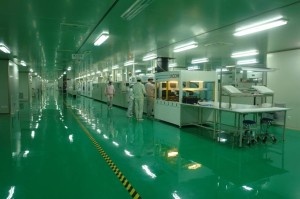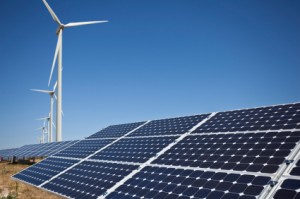In part 1 we have shown the potential of biomass. We will now deal with sun and water as sources of renewable energy. We will give an estimate of the maximum contribution of renewables. Solar and wind energy together could cover our entire present electricity consumption. Dedicated government stimulation of private use and production of electricity could be a major step towards a better public acceptance of renewable energy development. An important strategic lesson is the need to involve international developments in drawing national energy agendas.

In most debates on the energy future, the actual supply of energy is the dominant theme, whereas the underlying (national) strategy is at least of equal importance. Seen from a strategic European level we have to admit the much greater drive in USA, China and Japan to solve the energy (and climate?) problems. Their energy agendas should be leading for Europe and its individual states. Our industry should focus on the needs of these international customers, provide them with the products and technology required, and take home the best solutions for indigenous applications. Our strategy should be: how can we help China, Japan, and USA, earn our money there and what do we take home for ourselves. The lack of European collaboration will make itself be felt immediately. Also the agendas of big energy suppliers such as Russia and Saudi Arabia should be taken into account. We may expect Russia to continue being the ‘economy of waste of raw materials’, Saudi Arabia could very well surprise us with cheap electricity from their oil and gas fields complemented with solar energy from their empty deserts. They do have the financial resources, and the required technology is or can be made available.
 Onshore and offshore wind
Onshore and offshore wind
The limits of biomass as source of renewable energy were clearly shown in part 1: at most 10% with 5% as most likely. With energy from wind, technological limits come in sight unlike in the cases of solar energy and biomass. A doubling of the present yields at sea is not to be expected. Therefore we can simply use the calculations of professor David MacKay ( www.withouthotair.com ) as a basis for an estimate of the maximum possible energy yield from wind. Wind at sea could deliver 3 W/m2, at land 2 W/m2. In countries like the UK and the Netherlands, 5% of the land area covered with wind turbines could then supply 3% of total energy demand. Would that be feasible at all? An area at sea as large as the Netherlands would satisfy the whole need of the country. Once again: how realistic is that? Moreover, so far most energy projects at sea have suffered severe material and maintenance problems. Let us take an optimistic view and take 10% for energy from wind for an average EU state. In other parts of the world, things can be quite different. For barren plains like the Gobi desert or Arizona we can probably also use 3 W/m2 or even slightly more. And material requirements will be less strict there. Quite interesting in this context is the study “Global Resource Depletion” (André Diederen, TNO, 2010). It sounds like the Club of Rome 1972 report revisited. A real breakthrough to renewable energy from wind, sun and water will be hampered by a lack of lithium, steel, concrete, rare earths metals etc. Just like four decades ago, the challenge is again to reach the same or better results with much less or completely different materials. The well known “Factor 10” approach will be very essential. Anyway, the 10% upper limit for energy from wind will remain for a long time.
Solar energy as the ultimate answer?
The sun is the ultimate answer, as common knowledge tells us. The challenge is to bend this huge source in our way efficiently and affordably. Nature is not our best teacher here, as often is the case in other domains. Efficiency of most photo syntheses are low, as plants need to develop protective mechanisms against an abundance of light. Development of bio solar cells has been slow so far, precisely for this reason. The slow development of organic PV cells also has to do with these facts. In the long run, these developments will lead to exciting examples of ‘Factor 10’ improvements. But in solar energy, developments are going fast now, and we can make a few estimates for an average European country. MacKay comes up with a range of 5-20W/m2. Rather a wide range and with a lot of improved and new technology still to come, both in yields end equipments . We can therefore safely take 20W/m2 as the upper limit for calculations on the potential of solar energy achievable in 10 to 20 years from now. Covering 5% of the land area( UK,Nl) with solar panels would allow for a third of the total energy need. Once again, as with wind mills, how much do we accept on our roofs or in our backyards? No more than 1 or 2% of our total surface is a likely outcome. That means 7-14% of our energy demand. As food for thought: 3% of the Sahara surface would be sufficient for the whole of Europe.
100% sustainable energy: an utopia!
The cards have been dealt. Solar energy in the only renewable source with a major contribution to a sustainable energy supply. Sun and wind together are able to cover our electricity demand, about one third of the total. With a horizon of 25 years, no more than 30% of our total energy usage will be renewable: 5-10% from biomass, a maximum of 10% from wind and a sound 10% or slightly more from our solar panels. Within the same 25 years we might have constructed the better part of a high voltage electricity grid covering Europe with connections to Iceland and Northern Africa. That would guarantee the 1/3 of our energy being sustainable. At the same time we will have to work hard at energy savings to keep our total consumption at today’s level, to develop more or better forms of sustainable energy and to continue application of fossil sources in a clean, efficient and competitive way.
The aforementioned forms of sustainable energy are very well suitable for decentralised production, the more if electricity should be the main energy carrier of the future. A strategic choice of our governments for stimulation of private use and production of electricity would be a big step on this way. Popular involvement will be large, because such a policy would confirm already existing public convictions. On a long time basis we can utilize the collected small scale experiences for steps directed at sustainable energy at a larger scale.
